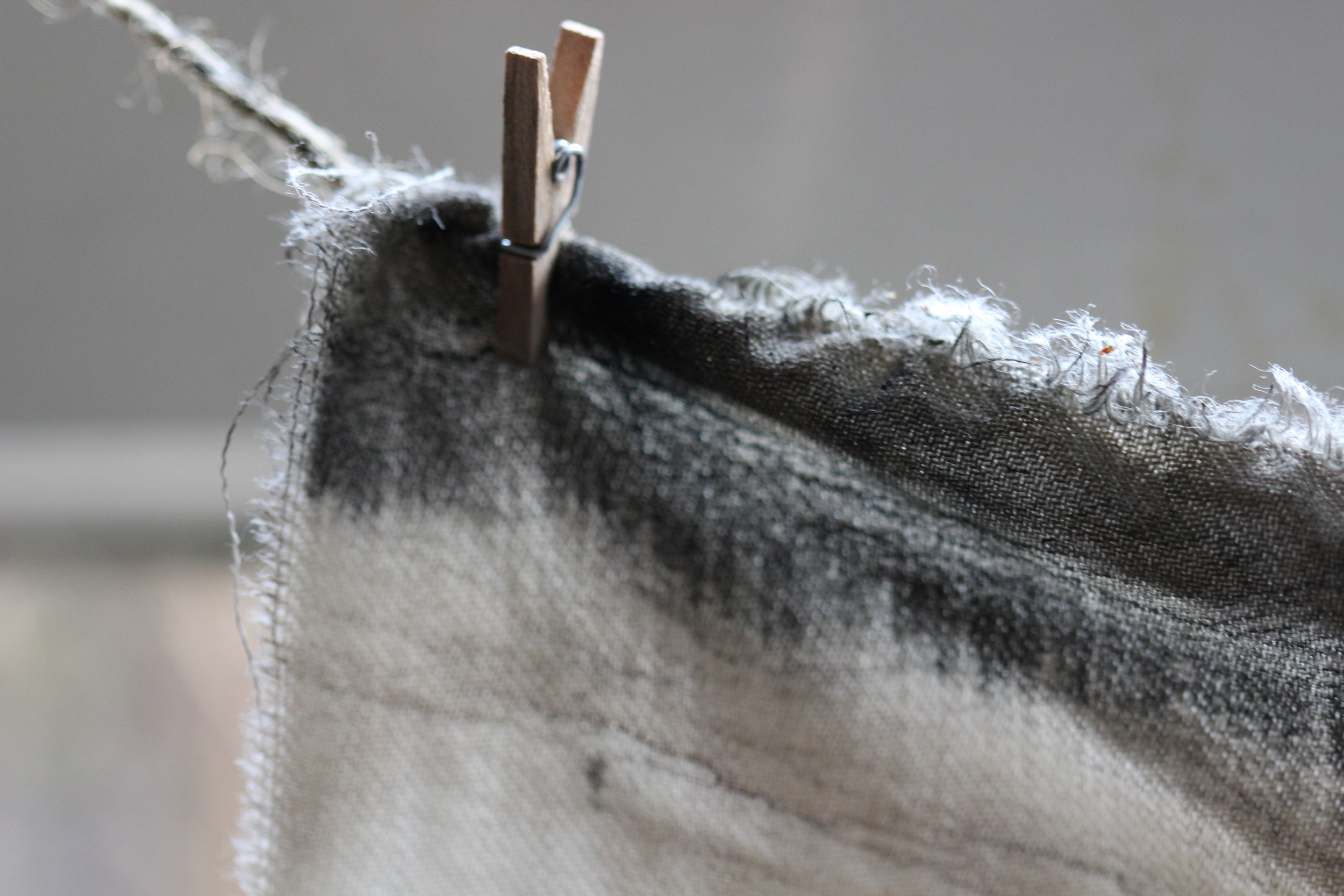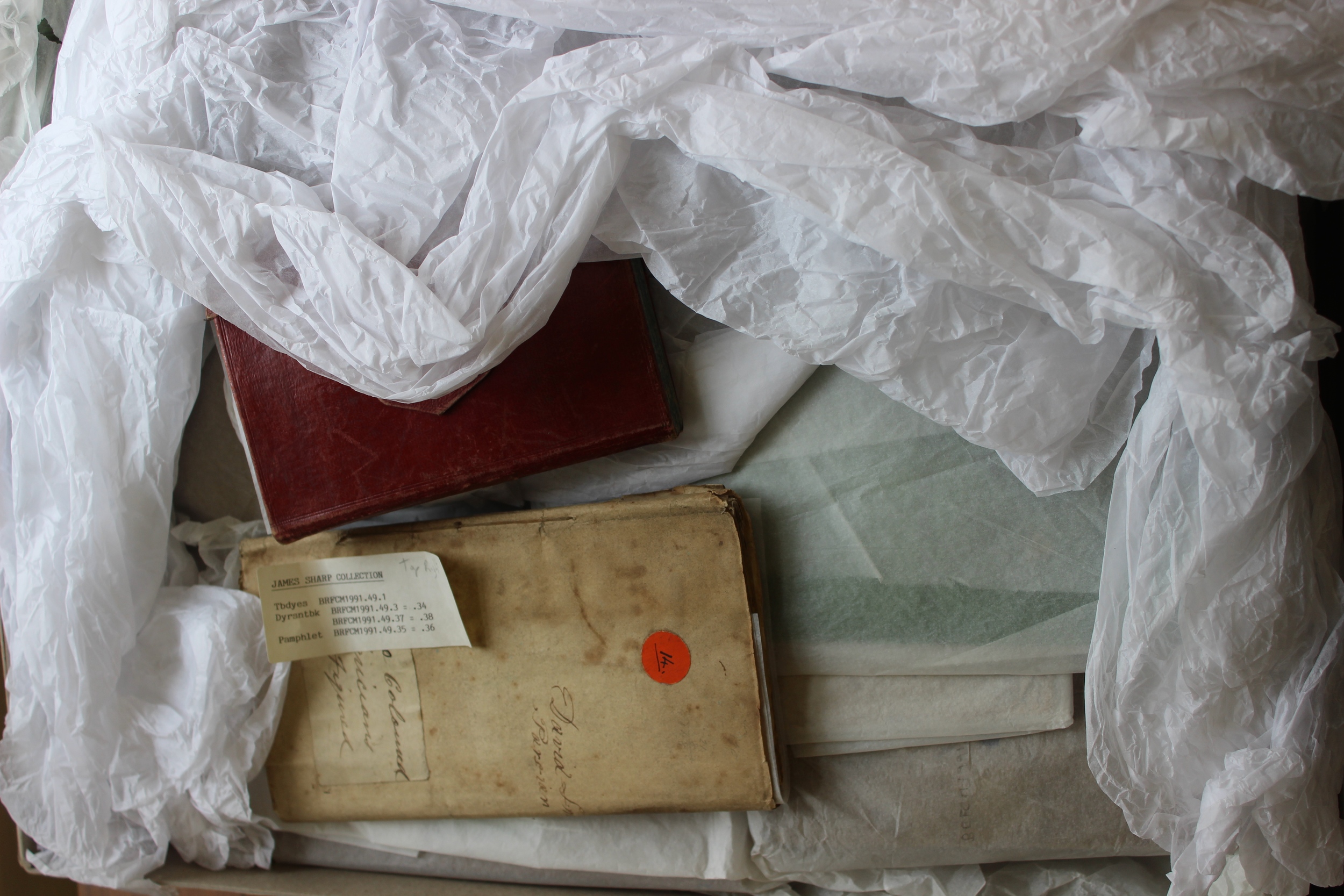I recently had the pleasure of working with Richard and Arron from R&A Collaborations on a film as part of the Devon Guild of Craftsmen project Home Ground. They came and spent a day with me at my studio and allotment (pretty cold in early February and not many dye plants growing...) and talked about slow, localised craft practices. Here it is...
studio
Slow work in the studio today. Oak galls and iron travelling along the edge of some local worsted cloth, dyer's detritus in the sink. Making time for a few stitches on my stitch journal. I should be tidying up, working out quantities and weights for some mordanting. Another day.
everydayness
It's been far too long since I last posted here. My blogging hiatus has mostly been due to research and writing commitments, the end of several projects all coming at the same time.
I'm continuing to work on a personal project that is exploring the area around a former dye works, walking a familiar route and recording using photography, collecting and making. The same research leads me back to the archive where I am investigating the communities that lived and worked in the area. I managed to collect some early foliage on my walk this week, wild raspberry and brambles, for a very small dye bath. The season has begun.
There is an everydayness in my approach to this project now, I've been working in the area for over two years, both with community groups and by myself. I'm interested in exploring whether a slowness of method can activate some reimagining of a place, long after most of the industry (in this case dyeing) has ended.
Some other things...
:: A couple of additions to my Spring/Summer workshop schedule here.
:: I'm presenting a paper as part of the 'Infinite and Various' Conference, about Bradford Textile Archive, at Bradford College in April. More details here.
:: I'm going to try to restart some regularity in blog posting, but most often at the moment I can be found here on instagram. Say hello if you use it too.
winter: inside
More light is beginning to filter into the days here but the greyness and dormancy of this time of year is something of a struggle.
I'm working on some new pieces, continuing with themes begun for this exhibition last year. The colours are more muted - the season dictates this - my local sources of colour are limited by this part of the growing year. I am enjoying the way the dyes travel through the wool I am using. Pieces are left to absorb colour for several days, and I find time each morning to go down to the studio to check on their progress and to maybe sadden the colour with a solution of oak galls and iron.
winter: outside
Gone to seed Japanese Indigo frozen in the back yard. I gathered enough seed earlier in the Autumn for planting in the next few weeks.
Dyer's chamomile - the beginning of a new year of growth just starting to show.
Scraps of local colour now under ice on the back wall. They have been outside 'weathering' for a few months. I imagine they will be beautifully soft when I bring them inside and start to stitch them.
Pick & Mix
Last year I was asked to make a piece of work for an exhibition called Pick & Mix that invited artists to work with items held by Bradford Textile Archive as inspiration for new work. It opens this week at the new Dye House Gallery at Bradford College. There are a range of responses to the archive by artists working in different media and include fantastic textile interpretations by Hannah Lamb, Liz Clay, Helen Parrott and Helen Farrar.
The archive holds the collection of the Society of Dyers and Colourists, an organisation based in Bradford since the 1880s. I have worked closely with their education team on some of my community-based projects and it is a fantastic resource. In the SDC collection there are many dyers' notebooks, dating back to the early nineteenth century and this is where I settled on my subject.
I have picked one of the many notebooks in the collection of David Smith (1819 - 1891): Halifax based dyer and printer, prolific writer and Strict Baptist minister. The notebooks in this collection span a long career, a record of recipes used and samples made but with other curiosities amongst his exacting instructions. His books brought to my mind the ‘commonplace books’ of an earlier time, a place to note down important texts, useful reminders, and passages from scripture. Book 41 is specific to the creation of black dyes on cloth. It is a handmade book, full of text, a few sample cloth pieces and some musical annotation.
My flyped (or folded) bundles of local worsted cloth have slowly absorbed a traditional black dye and are saddened using an iron mordant. They are heavily stitched along their folded edges. I am using these materials to explore the density of processes that now mostly happen out of view, and the arcane textile language that accompanied them.
Pick & Mix is at the Dye House Gallery, Lister Building, Carlton Street, Bradford BD7 1AY from 13th January - 18th February.
New Workshops 2015
Happy New Year. Just a quick post about a few workshops for the New Year now available to book via my Big Cartel site. All are held at my home studio near Saltaire, Bradford, West Yorkshire.
Slow Stitch: Saturday 7th March
Using recycled, re-used and naturally-dyed materials, learn about the pleasure to be had from slow hand-work. Make connections between the fabrics, fibres and threads you use and learn traditional stitch and patchwork techniques. We will talk about sustainability, simplicity, reflection, and multicultural textile traditions. Japanese Boro pieces, intricate mending and old quilt samples are among the textile treasures from my collection and we will be using these are inspiration. You will come away with the beginnings of a unique piece of work to continue to stitch in your own time.
Natural Dye studio day: April 25th
An opportunity to experiment. Using the wonderful harmonious colours produced using natural dyes I will prepare a selection of dye baths using locally grown plants from my allotment for you to use. This is an opportunity for beginners or those with some experience of plant dyeing to work on their own projects or have a play with colour and simple resist techniques. You will take away a selection of hand-dyed fabric, ideal for stitch or quilt projects, and lots of ideas to try out at home.
Natural Colour and Print: July 18th
New for 2015, a day using simple printing techniques and natural dyes. This experimental day gives you a chance to create two or three coloured prints on fabric using mordant pastes and print blocks. I will provide a selection of dye baths made from local plants and those that I grow at my allotment.
I'll be advertising some more workshops for later in the year in the Spring and will be back next week with some news about a forthcoming exhibition.
q and a
My partner David, who is a potter (and also a blogger), has asked me to take part in a blog hop. It seemed churlish to refuse, and also turned out to be quite a challenge as these are big questions. I’ve tried to be brief though…
What am I working on?
I’m currently on the cusp of a few different things. In my community-based practice the funded project that I’ve managed for two years exploring the textile heritage of Bradford is coming to an end (see my previous post). It’s been very rewarding work and has included creating community dye gardens, reminiscing sessions with community members about textile histories, textile making and dyeing projects, and archive-based research. I shall miss it. I’m also currently working on a dye and stitch based piece (work in progress pictured above) for an exhibition that opens in January 2015. Artists have been asked to respond to items from the extensive Bradford Textile Archive. I’m also about to submit the manuscript of my first book.
How does my work differ from others of it’s genre?
I’m not sure that this makes my work ‘different’ but I find that my community-based practice informs much of what I do. It’s a cyclical thing - all about making connections, sharing ideas and looking for the unforeseen outcomes. I like the way that slow textile processes can be used in all sorts of ways, and the pleasure I get from them I translate into my teaching and other work with communities.
Why do I do what I do?
For me the connection between making - using my hands - and thinking is an essential part of my life. I have been very lucky to find a way of using these ideas in a wide variety of ways and earn a living doing it. It also means I get to work with wonderful, passionate, diverse and interesting people.
How does my process work?
I like to start with one thing. It can be an object, a colour, a plant, a line of text, a texture. Through investigating it, researching it, finding stories about it I find a way of working with it – whether in teaching, community projects or in my own textile pieces. These processes are slow and require research, thought and reflection. It sometimes feels like a massive battle to get anywhere, but I’m much more patient than I used to be…
I'm passing these four questions on to two local friends of mine: Hannah Lamb, textile artist and academic, maker of beautiful and inspired textiles and installations, and Chrissie Freeth, tapestry weaver, writer and editor, whose slow approach to making and interpretation of textile heritage I much admire.
Community Cloth
The image above is of a piece of work called Sow: Sew, a collaborative textile piece made with sixty local stitchers and the input of many other people across my community who have tended and harvested plants and dyed all the cloth used. It's part of an exhibition of work from community groups involved in The Fabric of Bradford, a two year Hive project I've had the pleasure of co-ordinating.
The photograph has been taken in one of our dye gardens, which was a piece of waste ground tucked behind buildings in the middle of town, and is now a splash of secret colour. The stories we've unearthed around our city during this project, the shared personal and local histories, and the friendships made have been inspiring. I shall miss it.
writing, rhythm, reflection
Sketchbook
It's been a whole month since I last posted here, an unplanned break from blogging. The start of this term has been so full: teaching starting up again after a summer break, the final stages of a community project including an exhibition and a book, my own writing (more on this soon), work for exhibitions in the New Year and trying to find a rhythm again with it all. I must say that I'm finding that rhythm a little elusive at the moment. In quiet moments I have returned to reading Agnes Martin's 'Writings' and this phrase in particular,
'It is so hard to slow down to the pace where it is possible to explore one's mind.'
Well indeed. Time for reflection is often the first thing that vanishes when faced with multiple deadlines. Evaluation time is always built into the design of community-based arts projects and teaching, but time for reflective practice for the artist/teacher is often quite another thing. My personal strategy has not changed, I use my hand-stitching time as a moment to pause and problem solve. I just need to give myself more focused time to do it. Do you feel you have time for reflection in your work?













